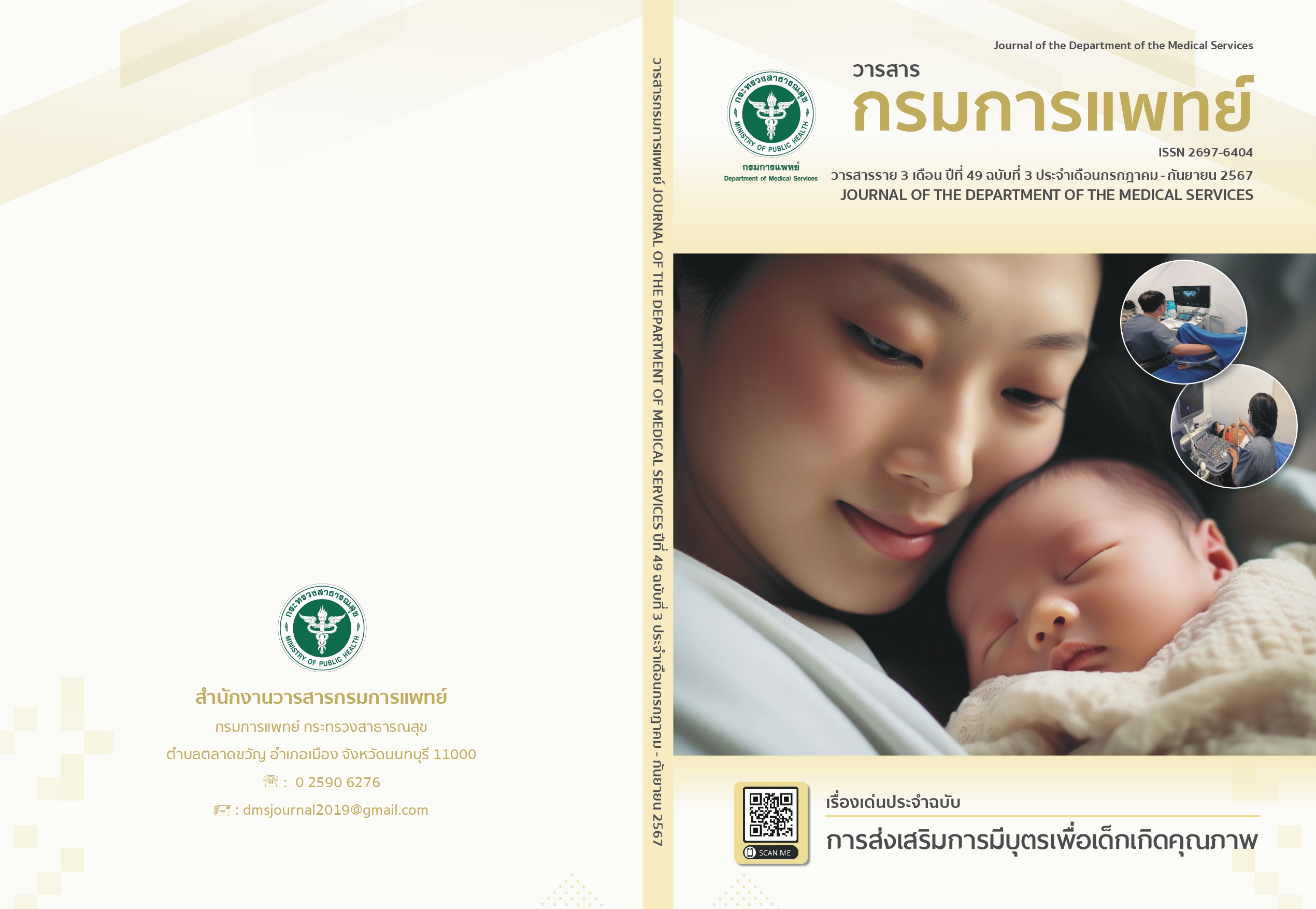Factors Associated with Acute Exacerbation Among COPD Patients Leading to Visit Emergency Room of Banhong Hospital, Lamphun Province
Keywords:
COPD, AECOPD, GOLD, Perception of diseaseAbstract
Background: Chronic Obstructive Pulmonary Disease (COPD) stands as the third leading global cause of mortality. Banhong Hospital contends with an alarming 160% acute exacerbation rate, incurring substantial treatment costs, diminished quality of life, and heightened mortality risk. Objective: To study the risk factors that associated with acute exacerbation among COPD patients leading to visit emergency room. Method: A case-control study was conducted on COPD patients visiting the emergency room due to acute exacerbation (AECOPD) were compared with no exacerbation from January 1st to June 30th, 2022. A sample of 30 individuals in each group was selected through simple random sampling. Data were collected through interviews from August 1st to December 31st, 2022, and analyzed using logistic regression. Result: Statistically significant factors associated with AECOPD by multivariate logistic regression method was only severity as GOLD C up (adjOR 57.85, 95% CI 3.10 - 1080.09, p – value .007), by univariate method included inappropriate perception of disease (adjOR 13.5, 95% CI 3.33 – 54.67, p – value < .001), respiratory infections (adjOR 11.77, 95% CI 2.92 – 47.46, p – value .001), improper inhaler technique (adjOR 10.55, 95% CI 1.22 – 90.66, p – value .032), inability to avoid triggers (adjOR 5.70, 95% CI 1.72 – 18.94, p – value .004), perception of disease as moderate level up (adjOR 5.55, 95% CI 1.84 – 17.49, p – value .003), and inadequate awareness of the frequency of emergency bronchodilator use (adjOR 4.03, 95% CI 1.37 – 11.84, p – value .011). Conclusion: The factors associated with AECOPD that should be modifiable included inappropriate perception of disease, improper inhaler technique, inability to avoid triggers, and inadequate awareness of the frequency of using emergency bronchodilators.
References
World Health Organization. The top 10 causes of death [Internet]. 2020 [cited 2022 Jan 14]. Available from: https://www.who.int/news-room/fact-sheets/detail/the-top-10-causes-of-death
Global Initiative for Chronic Obstructive Lung Disease. Global strategy for the diagnosis, management, and prevention of chronic obstructive pulmonary disease 2021 [Internet]. 2020 [cited 2022 Jan 14]. Available from: https://goldcopd.org/wp-content/uploads/2020/11/GOLD-REPORT-2021-v1.0-11Nov20_WMV.pdf
Health Data Center, Ministry of Public Health. Public health statistic A.C. 2015 [Internet]. 2022 [cited 2022 Jan 14]. Available from: https://lpn.hdc.moph.go.th/hdc/reports/report.php?source=formated/format_1.php&cat_id=6a1fdf282fd28180eed7d1cfe0155e11&id=62cdb786f231afbaaaaaac1d5ff844b0
Müllerová H, Shukla A, Hawkins A, Quint J. Risk factors for acute exacerbations of COPD in a primary care population: a retrospective observational cohort study. BMJ Open 2014;4(12):e006171.
Anderson F, Carson A, Whitehead L, Burau K. Age, race and gender spatiotemporal disparities of COPD emergency room visits in Houston, Texas. Occupational Diseases and Environmental Medicine 2015;3:1-9.
Lee J, Jung HM, Kim SK, Yoo KH, Jung K-S, Lee SH, et al. Factors associated with chronic obstructive pulmonary disease exacerbation, based on big data analysis. Sci Rep 2019;9:6679.
Pothirat C, Tosukhowong A, Chaiwong W, Liwsrisakun C, Inchai J. Effects of seasonal smog on asthma and COPD exacerbations requiring emergency visits in Chiang Mai, Thailand. Asian Pac J Allergy Immunol 2016;34(4):284-9.
Dong H, Hao Y, Li D, Su Z, Li W, Shi B, et al. Risk factors for acute exacerbation of chronic obstructive pulmonary disease in industrial regions of China: a multicenter cross-sectional study. Int J Chron Obstruct Pulmon Dis 2020;15:2249-56.
Gupta B, Kant S, Mishra R, Verma S. Nutritional status of chronic obstructive pulmonary disease patients admitted in hospital with acute exacerbation. J Clin Med Res 2010;2:68-74.
Kamthong S, Supametaporn P, Juntarawijit Y. Factors predicting acute exacerbation in patients with chronic obstructive pulmonary disease. Nursing Journal 2019;46(1):126-36.
Kuwalairat P, Markpirom K, Ratanaopas S. Determinants of acute exacerbation with emergency department visit in patients with chronic obstructive pulmonary disease. KKUJM 2017;3(2):29-41.
Kim JK, Lee SH, Lee BH, Lee CY, Kim DJ, Min KH, et al. Factors associated with exacerbation in mild-to-moderate COPD patients. Int J Chron Obstruct Pulmon Dis 2016;11:1327-33.
Boonreung J, Suwanno J, Phonphet C, Petsirasan R, Thiamwong L. Predictors of chronic obstructive pulmonary disease severe acute exacerbation. Thai J Cardio-Thorac Nurs 2017;28(1):111-28.
Wunnapuk K, Pothirat C, Prapamontol T. Investigation of DNA damage among chronic obstructive pulmonary disease (COPD) patients during high and low air pollutants in Chiang Mai province. Thailand Science Research and Innovation 2018.
Khongton W, Wattanakitkrilert D, Pongthavornkamol K, Rittayamai N. Factors influencing acute exacerbations in patients with chronic obstructive pulmonary disease: a prospective study. JTNMC 2019;34:76-90.
Kaptein AA, Scharloo M, Fischer MJ, Snoei L, Cameron LD, Sont JK, et al. Illness perceptions and COPD: an emerging field for COPD patient management. J Asthma 2008;45(8):625-9.
Songkhao S, Masingboon K, Chantamit-O-Pas C, Ponpinij P. Factors influencing prevention of acute exacerbation in patients with chronic obstructive pulmonary disease. TPHSJ 2022;17(4):335-43.
Braido F, Baiardini I, Menoni S, Bagnasco AM, Balbi F, Bocchibianchi S, et al. Disability in COPD and its relationship to clinical and patient-reported outcomes. Curr Med Res Opin 2011;27(5):981-6.
Rodkantuk E, Hirunchunha S, Petsirasan R. Acute exacerbation symptoms among patients with chronic obstructive pulmonary disease, triggering factors, and management strategies. JRN-MHS 2017;37(2):1-13.
Naklamai A, Wattanakitkrileart D, Pongthavornkamol K, Chuchottaworn C. The influences of perceived severity, social support, and uncertainty in illness on health status of patients with chronic obstructive pulmonary disease. J Nurs Sci 2011;29(2):46-55.
Poletti V, Pagnini F, Banfi P, Volpato E. Illness perceptions, cognitions, and beliefs on COPD patients' adherence to treatment - a systematic review. Patient Prefer Adherence 2023;17:1845-66.
Kelsey JL, Whittemore AS, Evans AS, Thompson WD. Methods in observational epidemiology. 2nd ed. New York: Oxford University Press; 1996.
Nau DP, Ellis JJ, Kline-Rogers EM, Mallya U, Eagle KA, Erickson SR. Gender and perceived severity of cardiac disease: evidence that women are “tougher”. Am J Med 2005;118(11):1256-61.
Department of Mental Health, Ministry of Public Health. 2 questions screening for depression [Internet]. 2016 [cited 2022 Jan 14]. Available from: https://dmh.go.th/test/download/files/2Q%209Q%208Q%20(1).pdf
Downloads
Published
How to Cite
Issue
Section
License
Copyright (c) 2024 Department of Medical Services, Ministry of Public Health

This work is licensed under a Creative Commons Attribution-NonCommercial-NoDerivatives 4.0 International License.
บทความที่ได้รับการตีพิมพ์เป็นลิขสิทธิ์ของกรมการแพทย์ กระทรวงสาธารณสุข
ข้อความและข้อคิดเห็นต่างๆ เป็นของผู้เขียนบทความ ไม่ใช่ความเห็นของกองบรรณาธิการหรือของวารสารกรมการแพทย์



